Discover the most popular dishes of Cambodia including fish amok and beef lok lak as well as surprises like fried tarantula!
Bet you've never heard of these delicacies – unless, of course, you've also visited the gorgeous Kingdom of Cambodia. We'll be honest, we'd never come across Cambodian food before our visit. But boy were we in for one big treat when we discovered it!
Cambodia has all the flavors and fresh ingredients unique to Southeast Asia, with an abundance of steaming yummy curries and exciting noodle dishes to keep the taste buds exhilarated all day long.

For our trip around Cambodia, we spent a lot of time in the capital, Phnom Penh, and also in Siem Reap, where we were able to discover the different flavors of the Khmer Kingdom. If you do get the chance to squeeze in a few cooking classes on your trip to Cambodia, we highly recommend it. It's one of the best ways to learn more about the country's rich history, usually through the eyes of a local.
This is our roundup of the best traditional foods of Cambodia that need to go on your culinary bucket list as you eat your way around this fascinating country.

Advice for LGBTQ travelers to Cambodia
Cambodia is very welcoming of LGBTQ travelers and ranks as one of our most gay friendly places in Asia. We never had any issues anywhere in Cambodia. We were also delighted to find quite a large gay scene in Phnom Penh. Put it this way, Cambodia has never had any anti-gay laws in its history and as of 2018, steps towards gay marriage were taken with the passing of the Declaration of Family Relationship laws. For more, read our interview with local boy Aaron from Phnom Penh about gay life in Cambodia.
Where did Cambodian food originate from?
Since the Mekong River cuts straight through Cambodia, it's not surprising that water, rice, and freshwater fish have been the dominant elements of Cambodian cuisine for a very long time. As well as freshwater fish, Cambodia is blessed with 443 km of coastline, so seafood is also prevalent in the coastal regions.
During the rainy season, monsoons help turn Cambodia into a huge sea of rice paddies. Rice is the main dish in Cambodia, part of every meal, and often the main ingredient in snacks too. While a lot of Cambodian cuisine is similar to that of neighboring Thailand, Cambodian curries and sauces tend to be more watery.
Cambodian food has also been influenced by the peoples of China and Vietnam, along with French influences since the country was once part of the French Colonial Empire. While Cambodians do eat some meat, they also eat more unusual (at least to Westerners) things like grasshoppers and spiders. And if you're not able to handle the heat of spicy dishes such as those from Thailand then fear not because Cambodia uses far less chili than its neighbors!
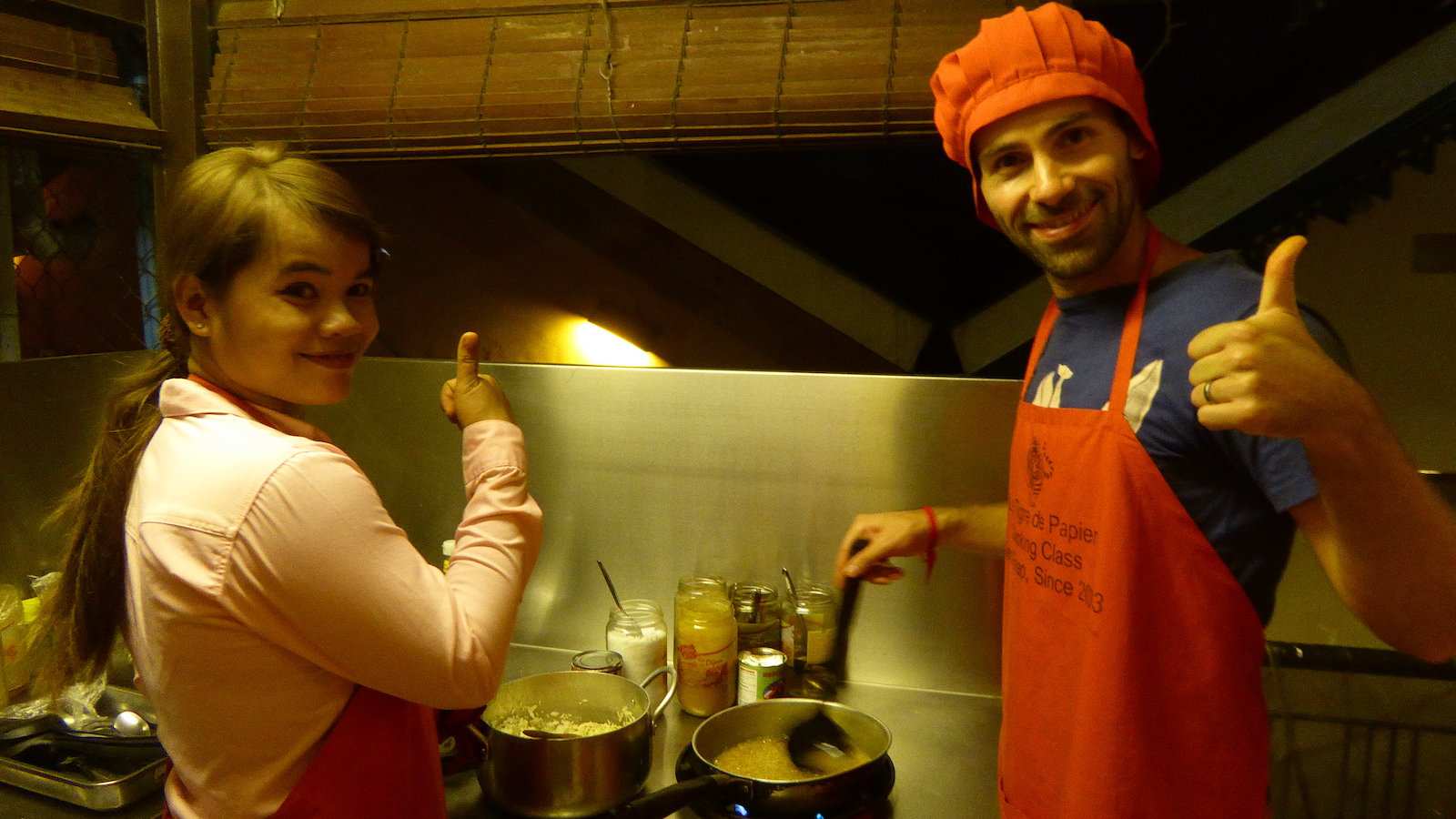
1. Amok Trei: Fish Amok – Cambodia's national dish
Fish Amok is the most well-known traditional food of Cambodia, generally accepted to be the country's signature dish. It is a thick, creamy fish-based curry that is also very popular in Laos and Thailand.
The recipe for Cambodian fish amok uses freshwater fish, lemongrass, chili, turmeric, and coconut milk. It is usually steamed and served inside a banana leaf shaped like a bowl, with rice and sometimes a fried egg. Traditionally, amok was made with fish or snails, but nowadays beef, chicken, or vegetarian variants (with tofu) can be found.
Amok is not meant to be spicy but rather zesty and flavorful. The traditional use of white river fish as the base attests to Cambodia's history of using water, rice, and fish in many dishes. The fish ends up being so tender and delicious that it just falls off your fork or chopsticks. We often find ourselves craving it on cold nights!
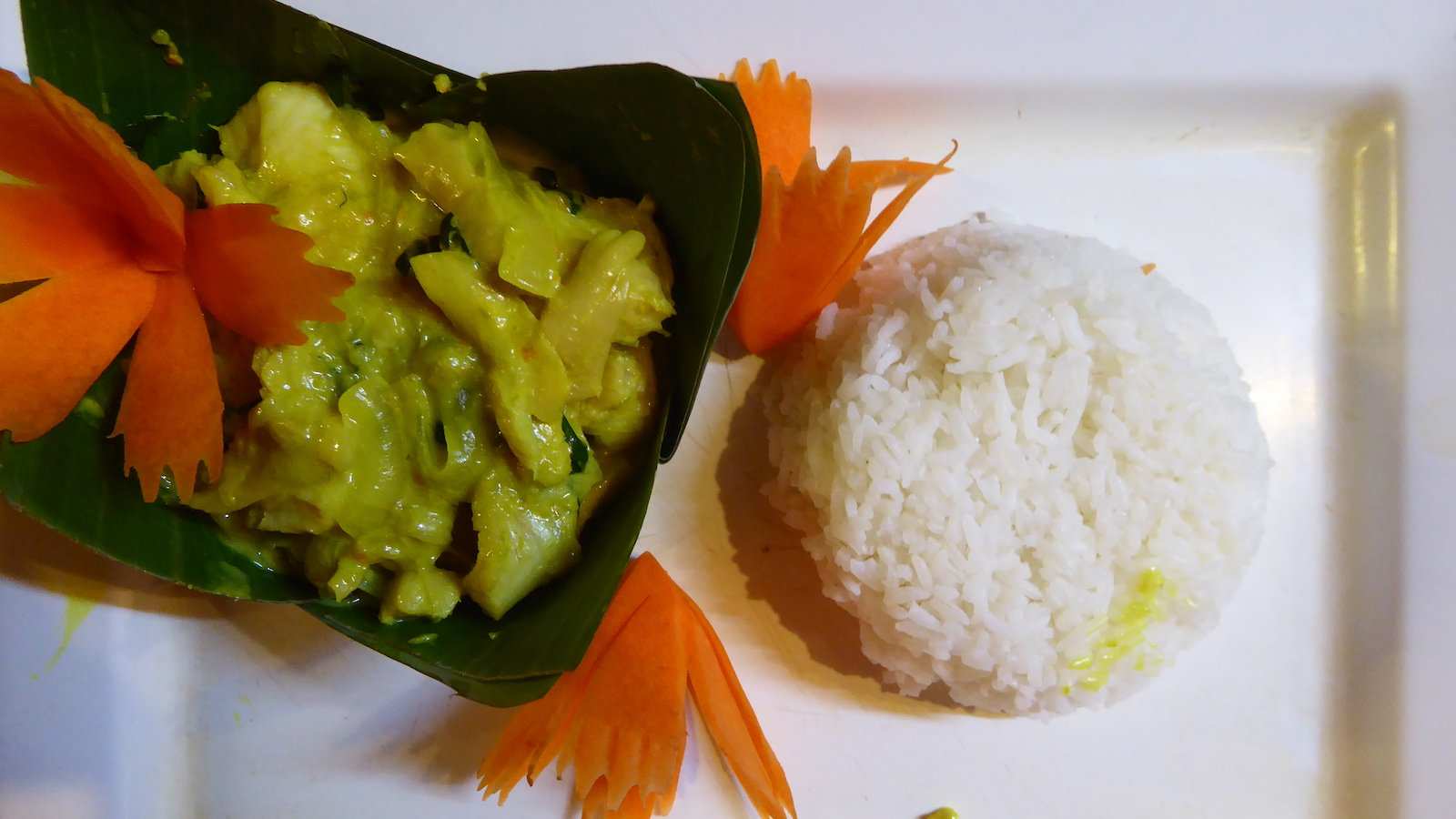
2. Khmer green mango salad
Mango salads are popular in Cambodia and throughout Southeast Asia. The Cambodian (also called Khmer) green mango salad is similar to the Thai papaya salad but uses a grated green mango as the base instead of unripe papaya.
The Khmer mango salad also uses some ingredients that are similar to the recipe for som tam papaya salad, in particular, lime juice mixed with crushed nuts, dried shrimp or smoked fish, chopped garlic, shallots, palm sugar, mint, and fish sauce. This is a healthy dish, which can be adapted for vegetarians or vegans by leaving out the dried shrimp and fish sauce.
Cambodian green mango salad perfectly balances the flavors of sour fruit, salty smoked fish, and sweet palm sugar, without any angry chili to burn your tongue off… Once again, Cambodian cuisine is like the sweeter, more mellow cousin of the fierce and fiery Thai cuisine!
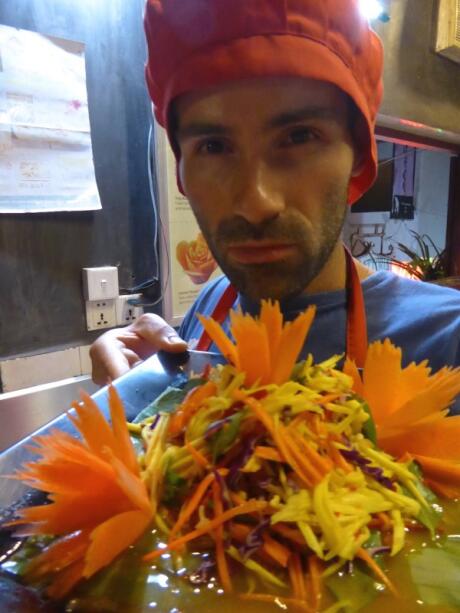
3. Beef Lok Lak
Beef lok lak is the Cambodian version of the Vietnamese “shaking beef” called Bo Luc Lak. Similar to the Vietnamese recipe, Cambodian beef lok lak originated from the French influence in the country, as before French colonization cows were used for labor more than meat.
Our recipe for Cambodian beef lok lak includes chopped thin slices of beef, stir-fried with onions, cucumbers, and tomatoes. The traditional dish is then served with rice, lettuce, and a fried egg for extra protein. To eat beef lok lak you put a bit of everything inside a lettuce leaf, roll it up, and then dip it in the mouth-watering sauce.
The star of the dish is the dipping sauce, made from lime juice, sea salt, and black Kampot pepper. Kampot pepper is also known as seaside pepper since it grows in the coastal provinces of Cambodia and is considered to be one of the best peppers in the world! But if you aren't able to get your hands on some, black pepper also brings out the tasty flavors of beef lok lak.
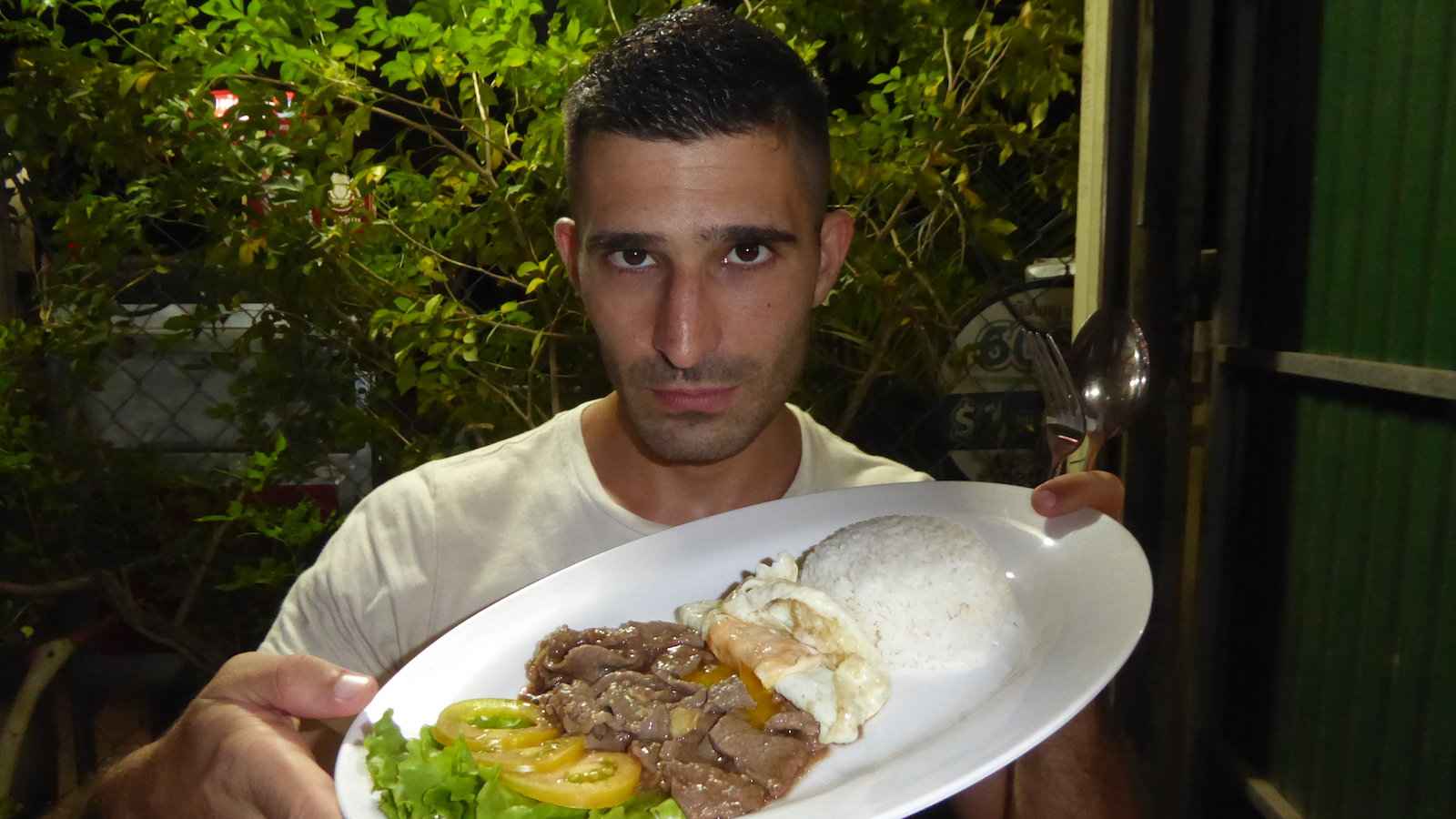
4. Cambodian Saraman Curry
Saraman is sort of the equivalent of Masaman curry in Thailand, as it is a beef curry originating from the Muslims of Cambodia who don't eat pork. It's widely known in Cambodia that the Cham people (a Muslim ethnic minority in Cambodia) sell the best beef in the markets, and this beef curry is also one of the most delicious we've ever tasted!
Cambodian beef saraman curry is one of the most complex dishes to make and since it's so time-consuming it's usually saved for special occasions. This complexity comes in part from the long list of spices, which should all be dry-roasted separately to make the curry paste. This paste is made up of coriander, cumin, star anise, cloves, cardamom, cinnamon, salt, red chillis, lemongrass, shallots, garlic, galangal, coriander, turmeric, kaffir lime, shrimp paste and grated coconut – phew!
After all that, the curry itself is cooked for at least two hours in this paste, while also adding coconut cream, coconut milk, palm sugar, fish sauce, and tamarind water. The result is well worth all the effort though, as it's the most divine, tender beef in an incredible spicy sauce you'll probably ever taste anywhere.
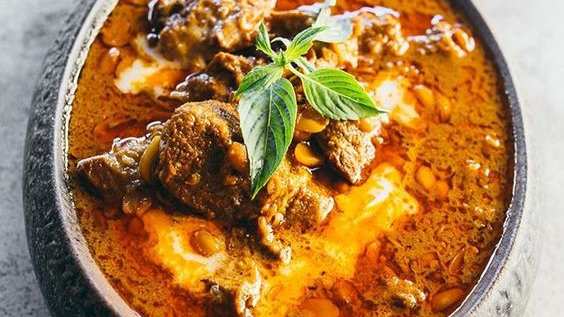
5. Num banh chok (popular Cambodian Noodle soup)
The name num banh chok means rice noodle and this is one of the most popular Cambodian noodle soup dishes that can be found throughout the country. It's typically served for breakfast and a common sight in Cambodian towns is women carrying the ingredients on a pole on their shoulders to be served up to customers in the morning.
Num banh chok (also sometimes just called Khmer noodles) is made with fresh rice noodles, fish-based green curry gravy, and toppings like cucumbers, fresh mint, basil, banana flowers, long beans, edible flowers, or wild leaves. The curry sauce is made from a base of white fish with lemongrass, turmeric root, garlic, ginger and kaffir lime.
Many Cambodians claim that the Chinese got the idea for making noodles from num banh chok when Thun Chey — a celebrated Cambodian revolutionary and scholar – was exiled to China from the Khmer Empire and had to sell num banh chok to get by. Well, whoever made them first, we're just glad they did now that we get to eat tasty num banh chok!
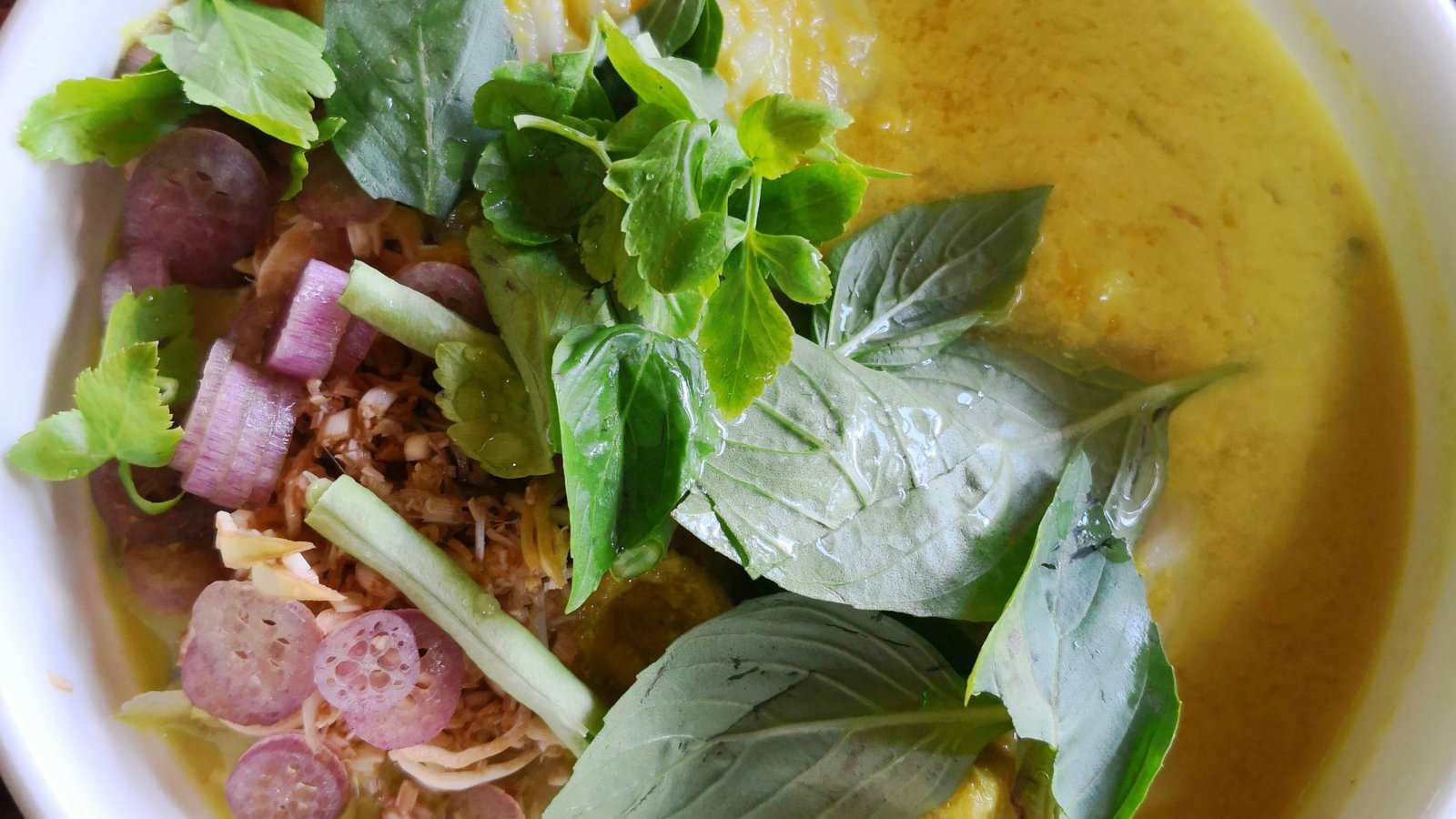
6. Bai Sach Chrouk (Barbecue pork with rice)
If a fish-based curry isn't your style for breakfast then you'd probably love Cambodia's other most popular breakfast dish: bai sach chrouk! This is a deceptively simple dish of pork and rice, but don't let that fool you into thinking it's bland, as it's a very yummy meal.
Bai sach Chrouk is made with thinly sliced pork that's marinated in palm sugar and fish sauce before being slow-grilled over warm coals. Seriously, nothing is more mouth-watering than waking up in Cambodia and smelling that smoky sweetness wafting through the streets each morning, signaling that it's time for breakfast!
The pork is served on a generous helping of white rice with fried egg and toppings like pickled cucumber, daikon radish, carrot, or ginger. It's also often accompanied by a bowl of chicken broth with scallions and/or fried onions. Perfect fare to set you up for a busy day of exploring Cambodia.
7. Nime Chow: Cambodian spring roll
Nime Chow (also sometimes spelled Naem Chao) is Cambodia's version of spring rolls, often called Cambodian fresh or raw spring rolls. Fresh spring rolls are not only tasty but, unlike the more traditional crispy spring rolls, they are healthier since they're not deep-fried.
This is another strong example of Vietnamese influence on Cambodian cuisine, as nime chow is very similar to the “Summer Rolls” of Saigon, which, in turn, are very similar to Chinese egg rolls. It's not known where spring rolls originated (although it's generally reported to be China) but each country's version has slight differences. They're all delicious though!
The filling for Cambodian spring rolls comprises various blanched cooked vegetables, lettuce, fresh herbs, noodles, and cooked meat (which is left out for vegetarians). Rice paper is used as the outside filling and the spring rolls are served with a dipping sauce consisting of chilli, crushed peanuts, and lime juice.
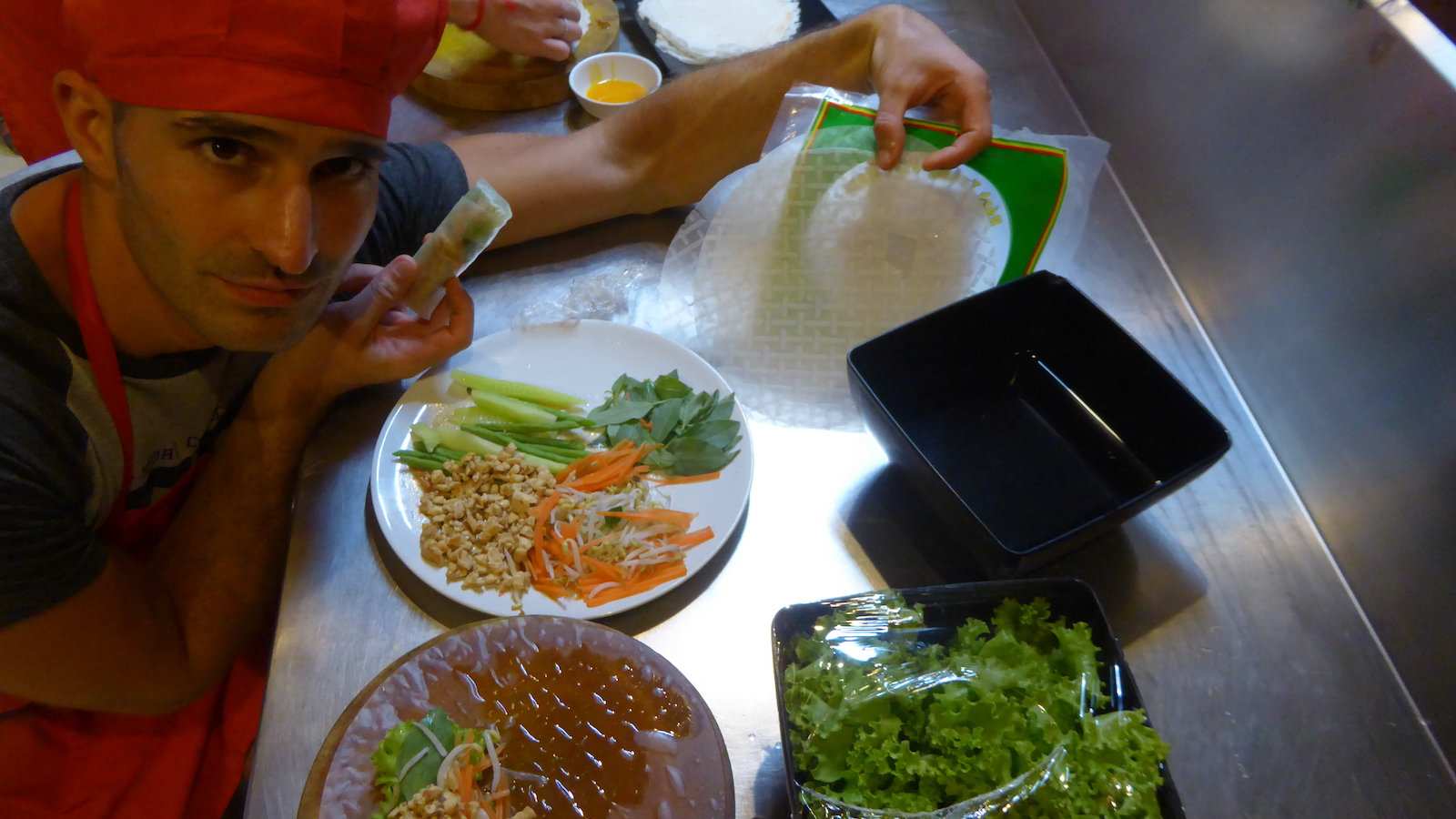
8. Kuy Teav (noodle soup)
Most Southeast Asian countries have their version of noodle soup and Cambodia is no exception. Cambodia's Kuy Teav is prepared with a base of cut noodles made from long-grain rice flour rather than glutinous rice flour. The name Kuy Teav can refer to just the noodles or the dish which also includes plenty of other ingredients.
The dish of Kuy Teav is another traditional breakfast food in Cambodia, which is sold from street food stalls across the country. It's made by quickly immersing the noodles in boiling water and then taking them out again, before putting them in a bowl with caramelized garlic oil. To this is added oyster sauce, soy sauce, fish sauce, sugar, and pork broth. Meat like pork balls or beef are added, or sometimes fish balls.
On top of all this, lots of garnishes and toppings are offered so the diner can choose to adjust the taste to their preference. Kuy Teav is never the same, with some ingredients deviating in different regions depending on what's available.
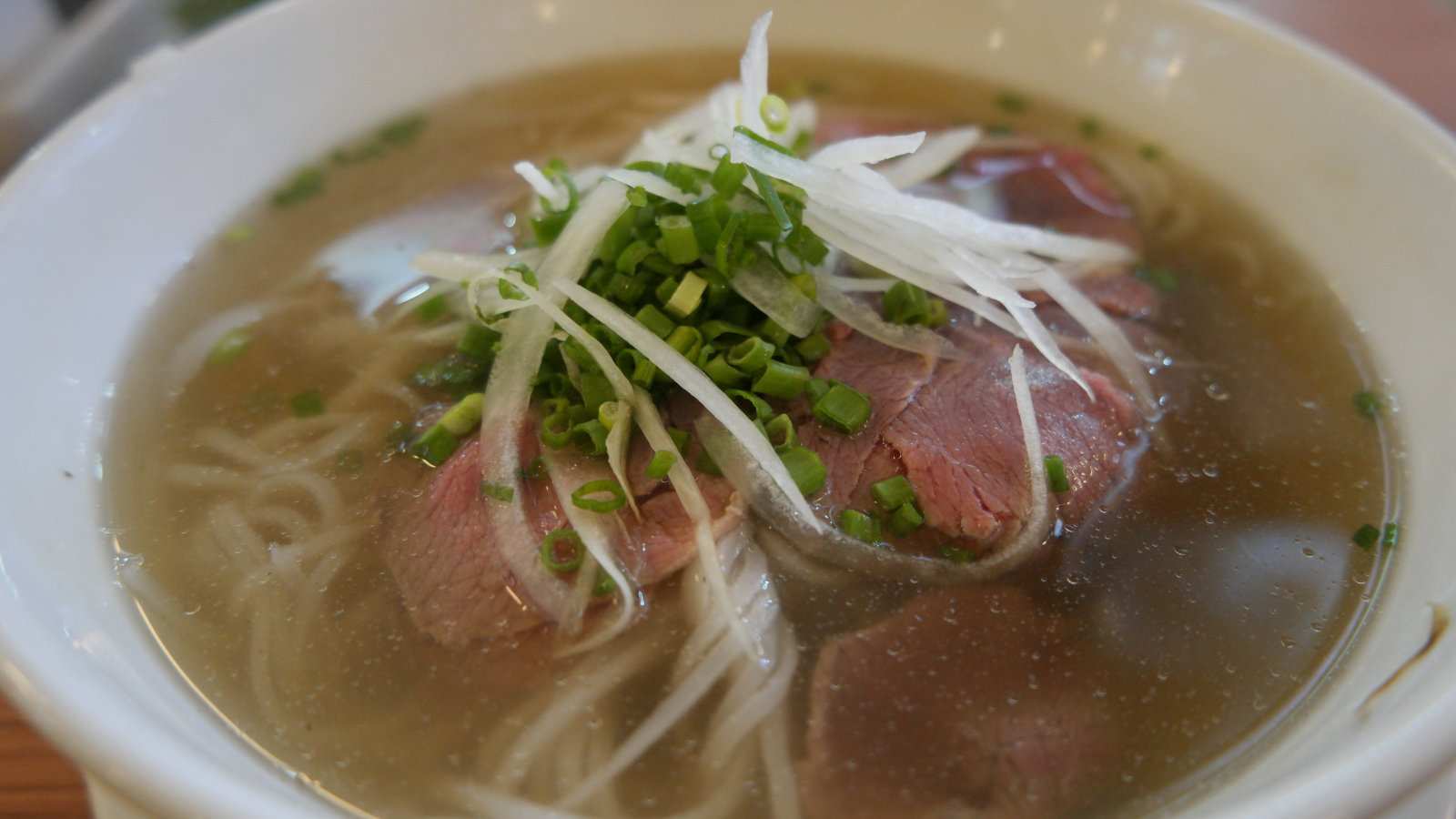
9. Num Sang Khya L’peou (pumpkin custard)
Cambodian num sang khya l'peou (also sometimes simplified to sankhya lapov) is a cool-looking dessert, where coconut custard is steamed inside a pumpkin. The custard itself is made using quite simple ingredients, just coconut milk, sugar and eggs. But since it's steamed inside a hollowed-out pumpkin, there's also hints of sweet pumpkin added to the flavor as well.
Sankhya lapov is usually served as a dessert during special occasions and religious festivals in Cambodia, often inside small pumpkins so you get your whole pumpkin filled with sweet custard. Otherwise, larger pieces can be cut out of big pumpkins to feed multiple people. It's also delicious served warm or cold.
We don't know about you but we want to make this delicious sweet treat next time we have a big pumpkin, instead of just carving it. The soft pumpkin flesh and creamy custard is a match made in heaven!
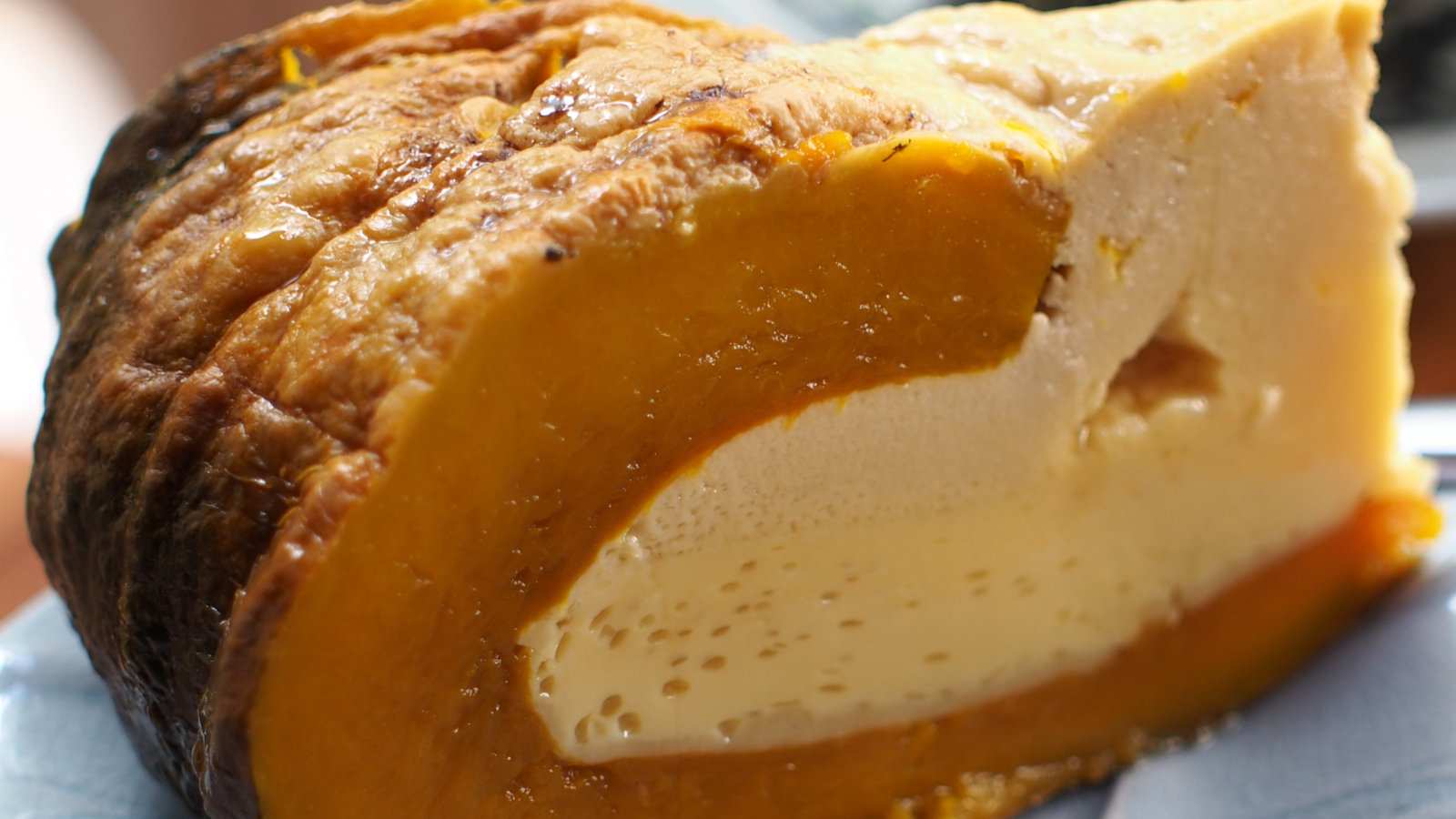
10. Lort Cha
Lort cha is a stir-fry dish from Cambodia made with rice pin noodles, vegetables, egg and various seasonings like fish sauce, garlic or green onion. Sometimes it also has chicken or other meat added to it, but the lort cha's main claim to fame is how simple it is to whip up with just vegetables and noodles.
This is a dish that is quickly made, often served up in street food markets for a snack or meal on the go. As well as being fast to cook, lort cha is both economical and healthy, as it usually includes plenty of fresh vegetables like Chinese broccoli in order to contrast with the chewier texture of the noodles. Everything is cooked in a mix of palm sugar, fish sauce and dark soy sauce, then usually served with some chilli sauce.
Chort la is also most often topped off with a soft boiled egg as the main source of protein and we've gotta say, we prefer this classic take without anything extra added.
11. Chha Trokuon (Cambodian morning glory)
Most meals in Cambodia are presented with a variety of small plates served alongside rice, eaten family-style. Chha trokuon is Cambodia's version of stir-fried morning glory and one of the regular dishes served as part of a Cambodian meal when a green vegetable dish is wanted. Many Southeast Asian countries have their own versions of stir-fried morning glory because water spinach is so abundant across the region.
Morning glory (or water spinach) grows in waterways without much in the way of help, which means it's a very affordable way for locals to get some nutrition into their food. Plus, it's so tasty! Chha trokuon is made by blanching the morning glory then transferring it to an ice bath before stir-frying it with garlic, chili, soy sauce, oyster sauce, and sesame oil.
After stir-frying, the morning glory is then boiled in stock and chilli oil before being served with a garnish like fried garlic or chopped-up chillies.
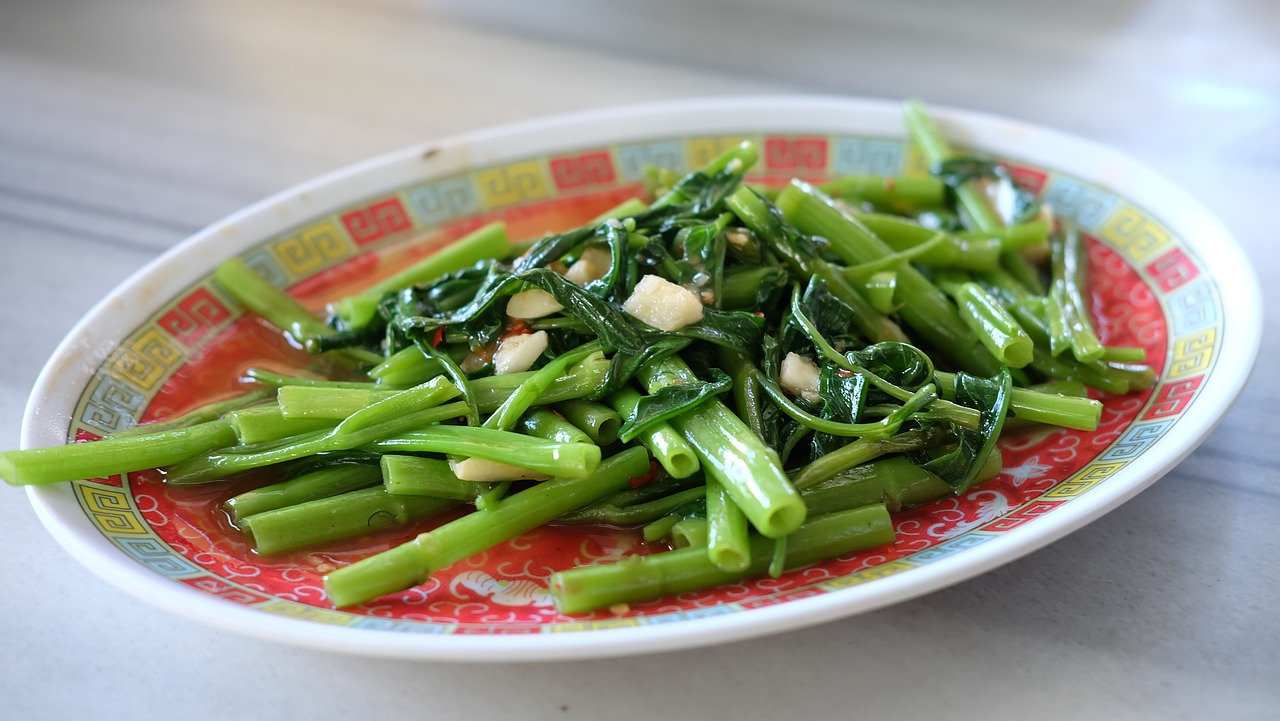
12. Kwah Ko (Cambodian sausage)
For those who like spicy sausages (teehe) we present to you the delicious Cambodian kwah ko! Now the Cambodian sausage isn't spicy in terms of heat, we've mentioned already that Cambodian cuisine is far less fiery than Thai or Vietnamese food, but it is spiced with flavorful ingredients which elevate the humble sausage beyond what you might be used to.
Kwah ko is made by filling pork casings with minced beef or pork, along with rice, galangal, garlic, kaffir lime leaves, fish sauce and paprika. Occasionally things like lemongrass or red chillies might be added, depending on local recipes and tastes. The sausages are left to dry, and during this time the rice starts to ferment, which gives the kwah ko a sour flavor as well.
Traditionally, kwah ko is eaten with a dipping sauce called tuk trey. This is made with fish sauce, rice vinegar, sugar, garlic and chilli – so if you like spiciness then you can smother your sausage in sauce!
13. Num ansom chrouk (Rice cake filled with pork)
Num ansom chrouk (also sometimes spelled chrook) is a savory sticky rice cake that's usually prepared during festivals and worship ceremonies in Cambodian culture. Ansom chek is the sweet version, very similar to num ansom chrouk but with banana inside the parcel instead of pork.
Cambodian women make hundreds of num ansom chrouk in the days leading up to major celebrations like Ancestor's Day or a wedding – then share them with friends and family as well as offering them to monks on the day. The filling is made from rice and mung beans, both of which are soaked in water for 8 hours before the cooking begins.
The rice is then cooked in a sweet coconut milk and sugar mixture. Then the rice, mung bean and slices of marinated pork are put into little parcels wrapped with banana leaves – which have also been dried in the sun for hours. These are then cooked in boiling water for 4-6 hours before finally being served and sometimes even fried again. We can definitely see why they are saved for special occasions!
14. Kuay Namuan: Bananas Cooked In Coconut Milk
For a sweet and comforting dessert in Cambodia you can't go past kuay namuan, which is simply bananas cooked in coconut milk. From one extreme to the other as this is a much easier dish to attempt at home than num ansom chrouk!
To make kuay namuan you cook sliced bananas in coconut milk with a little bit of sugar until it's thick and creamy, making sure the bananas get soft but not mushy. You are rewarded with a simple, warming bowl of yumminess, that simultaneously reminds us of home and a tropical evening on holiday.
Bananas are very important and plentiful in Cambodia, many locals only survived the Khmer Rouge regime by eating wild-growing bananas when rice was scarce. Bananas are also excellent sources of potassium and other nutrients, as well as being yummy. Cambodians call bananas chek, so if you see other dishes with chek in the name, you know it's going to be banana.
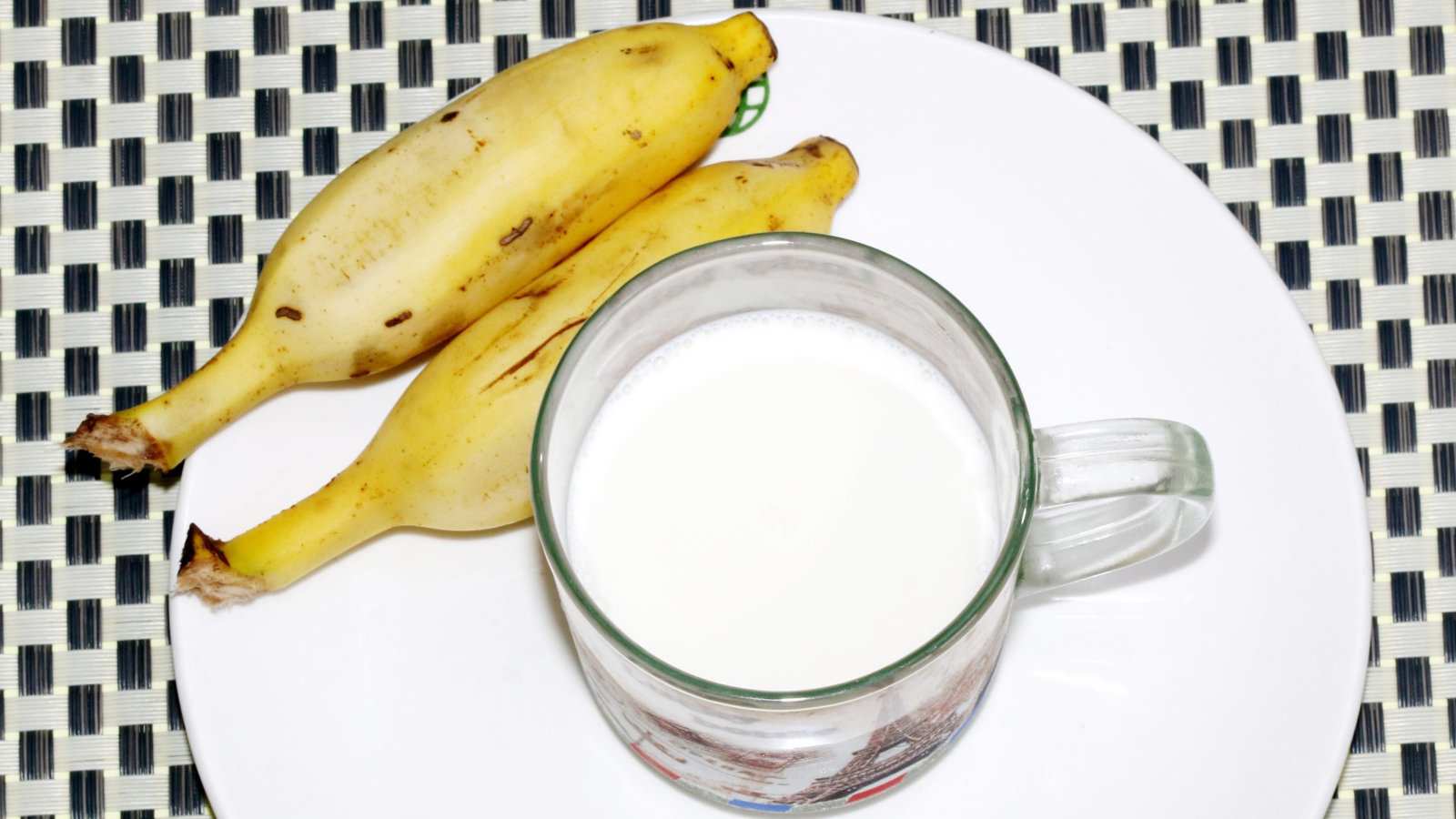
15. Bei Dom Neib: Cambodian mango sticky rice
Our other favorite Cambodian dessert is mango sticky rice, which is also super simple and totally scrumptious. All you need is rice, palm sugar and mango! Since rice makes up such a large part of the Cambodian diet it makes sense that the glutinous version would also be used for desserts.
We love mango by itself, and sweet sticky rice just elevates the juicy fruit. To make bei dom neib the rice is cooked in water, then the palm sugar and coconut milk is cooked together until it starts to caramelize, which is when the rice is added. This is only cooked for a while before it's ready to serve, with slices of fresh, peeled mango.
The sweet mango is perfect with the sticky rice and if you're lucky enough to get it served up to you in the shape of a smiling face like we were, all the better!
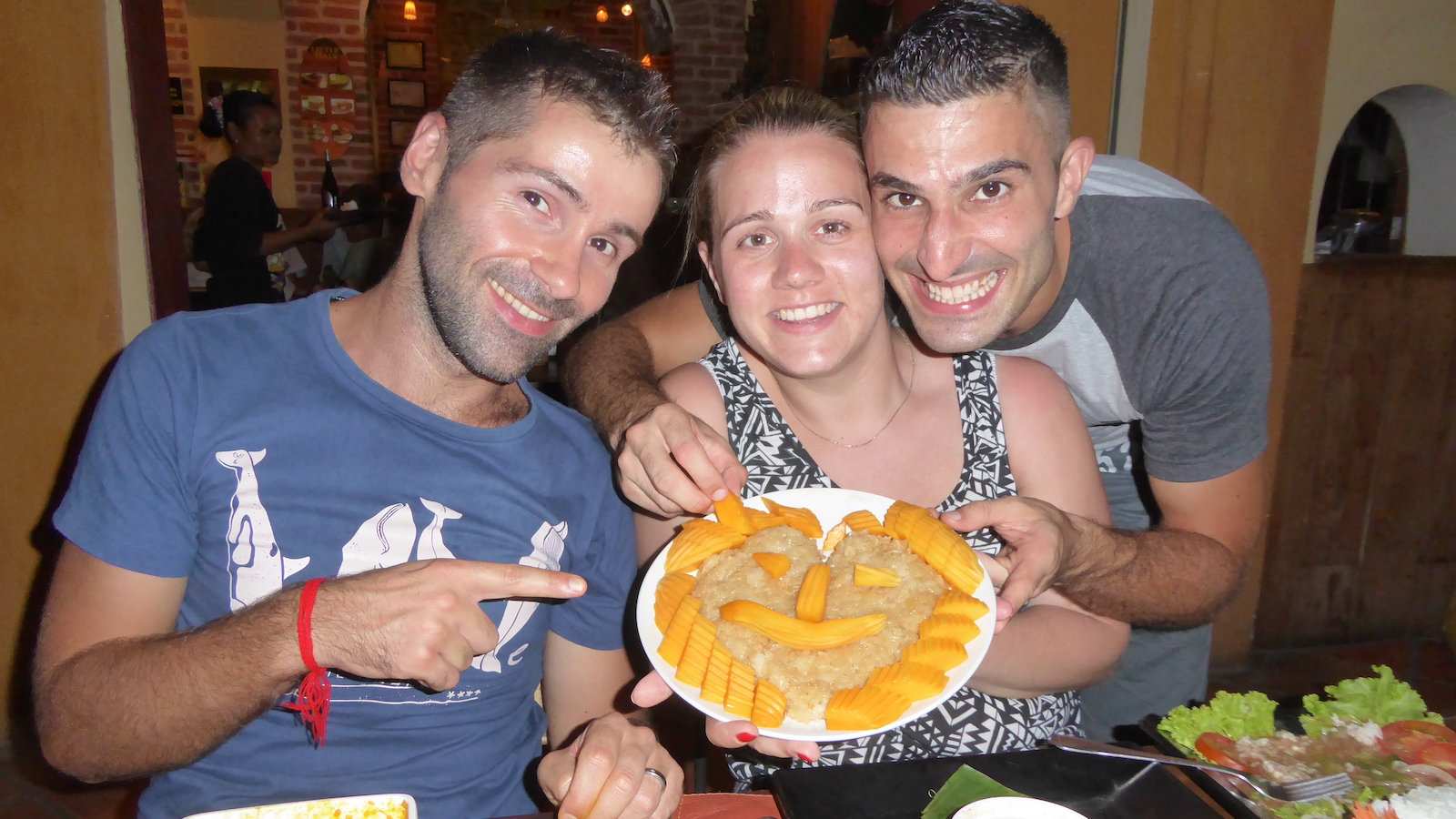
Read more travel adventures like this in our book!
We've published our very own gay travel book called, ‘Out in the World'. It has all our practical safety tips, first-hand advice, and travel stories from some of our favorite destinations.
We hope it inspires you to have a fun and safe trip!
Click on the book to order:

For more inspiration:
- Make sure you also read our interesting facts about Cambodia that you might not have known already
- Check out our gay travel guide to Siem Reap if you're planning to visit Cambodia
- As well as our itinerary for visiting Phnom Penh
- If you want to drool over more yumminess, check out the best traditional foods of Thailand
- And the best traditional Vietnamese dishes you will want to eat immediately
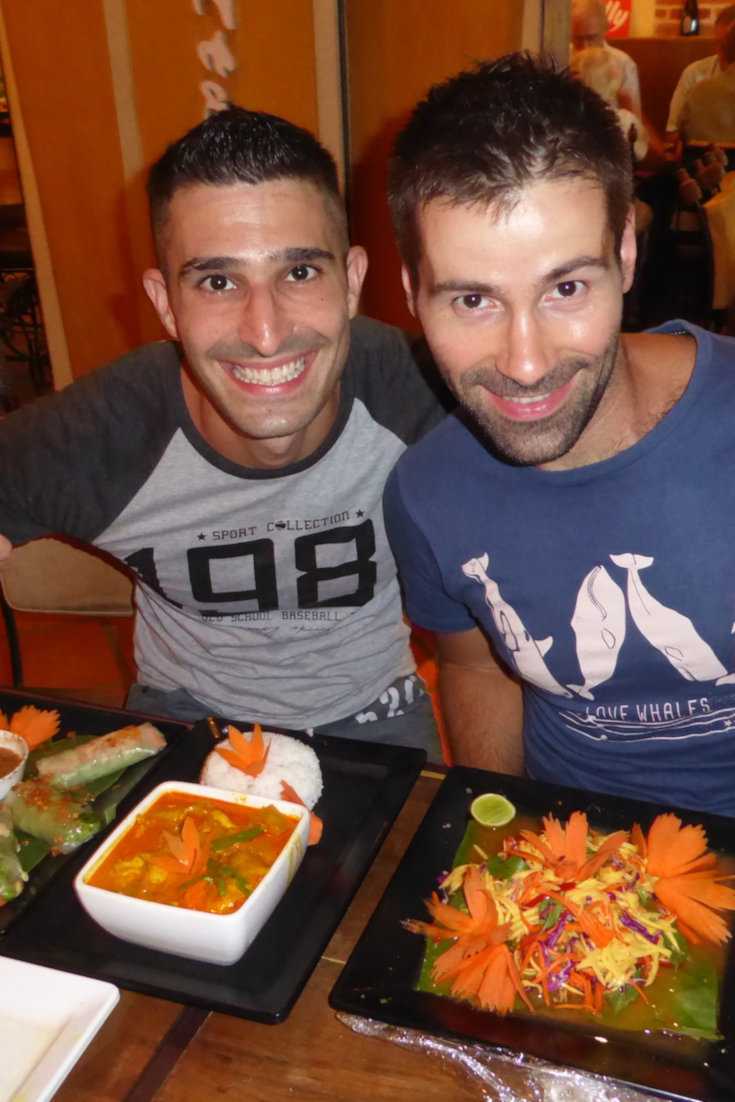

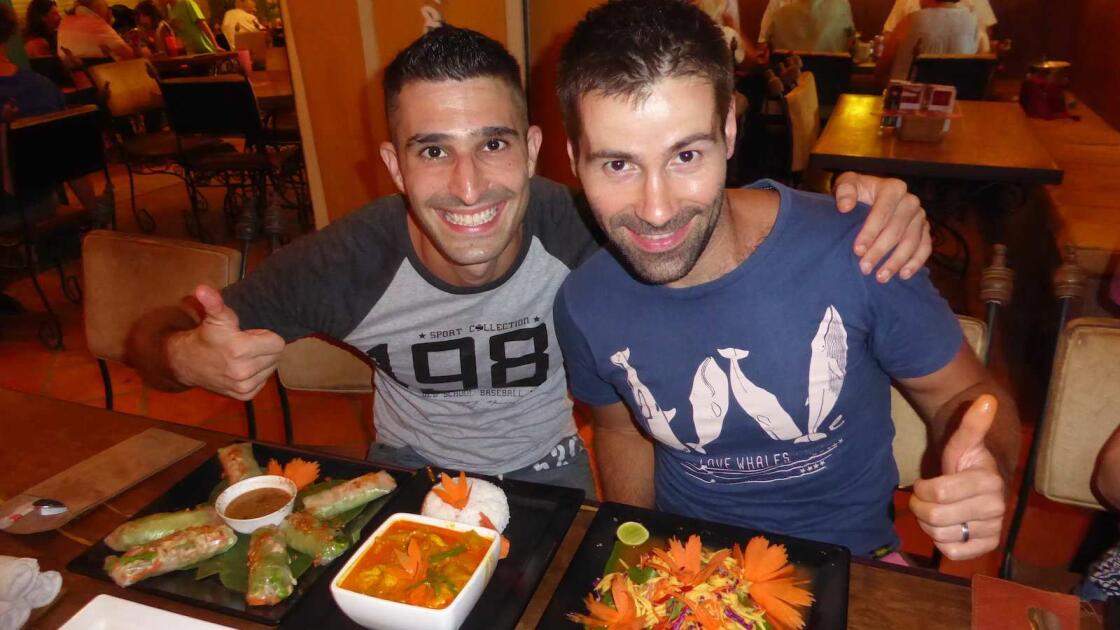
Tuesday 8th of November 2016
1.5
caryl
Tuesday 25th of August 2015
We've still yet to try a vegan version of the 'beef lok lak' - saw one in town but just not got round to it... however, i've really taken a shine to Cambodian food and there's just so much to try. I love the kroeung curry paste (so unique) and have been experimenting with using it in other dishes.
Lovely pictures of you both!
Nomadic boys
Tuesday 25th of August 2015
Thanks Caryl xxxx
Adam
Thursday 21st of May 2015
I remember the food in Cambodia being some of my favorite from all of Southeast Asia. It was totally surprising because I hadn't heard much of Cambodian cuisine before visiting - Thai food usually makes the news... But the food I ate in Cambodia as out of this world! I'm going to check out your Lok Lok recipe - that was one of my fav dishes
Aggouni
Monday 18th of May 2015
What the Bugs , i love it , thanks for sharing .
Nomadic boys
Monday 18th of May 2015
Thank you :)
Wayne Seto
Thursday 14th of May 2015
I was in Cambodia in 2010 and forgot how good the curries were until I read this post. I do enjoying trying different kinds of food, but the bugs are a hard for me to swallow (no pun intended). Great post! Happy travels!
Nomadic boys
Thursday 14th of May 2015
Hi Wayne and thanks for your comment. Totally agree about Cambodian curries. We were pleasantly surprised. The water bug particularly hard to swallow for us :)